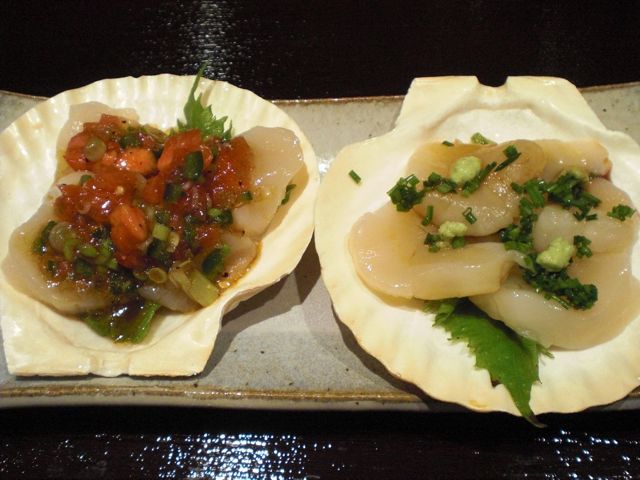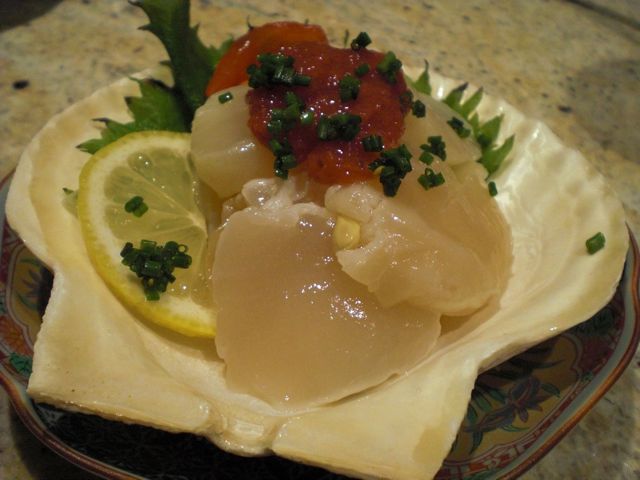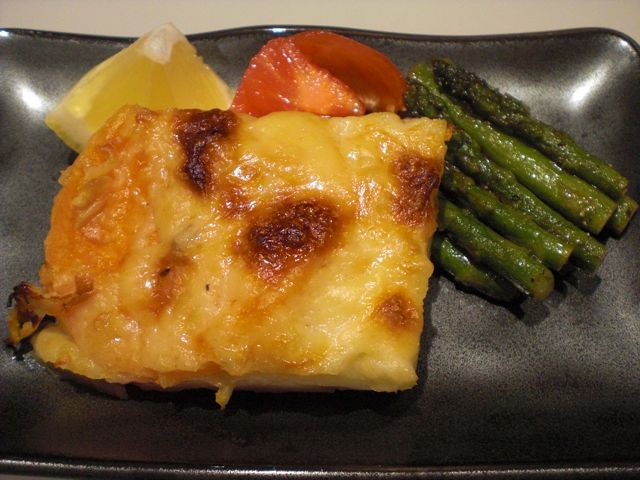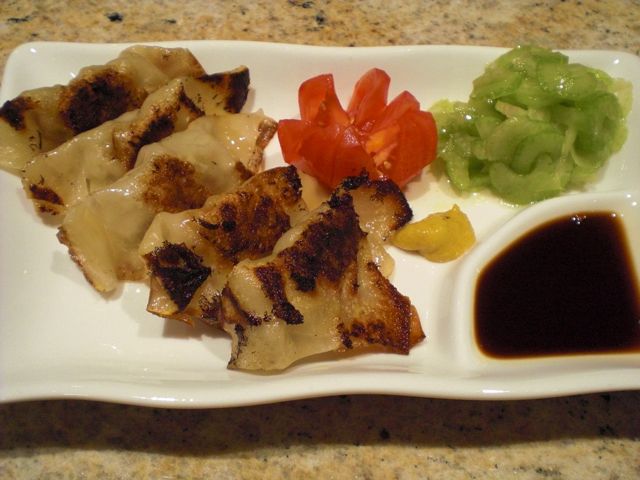Sunday, December 6, 2009
Fried Ramen noodle 焼きそば
Yakisoba 焼きそば is another regular "teibann" 定番 dish in Izakaya. There must be as many variations as numbers of people who make this dish. I make many variations myself depending on what is available in my refrigerator or freezer. This time, I found the last of several packages of frozen ramen noodle from "Nishiyama seimen" 西山製麺 that I had bought some time ago. Since I am originally from Sapporo, I am partial to their noodles. They make good ramen noodles either dry or "raw" 生ラーメン (frozen).
I just boiled them for 3-4 minutes or until the noodles are cooked but still firm (al dente). Meanwhile, I chopped cabbage (2-3 leaves), onion (one small), carrot (one small), garlic (one clove), and separated oyster mushroom or "maikake" 舞茸 (which I happened to have). I also happened to have a leftover poached chicken breast with black vinegar sauce. (You could use any type of meat or sea food, shrimp, fish etc, either raw or cooked, or you do not have to use any meat.) I just sliced and cut the chicken into bite sized pieces. In a frying pan, heat 1tbs of peanut oil with a splash of dark sesame oil. When the oil is hot, add the onion, cabbage, and carrot and saute. Season with salt and back pepper. When these are soft, add garlic and mushroom, saute another minute and add 1-2 tbs of sake or water and keep sauteing until water evaporates (2 or so more minutes). Add about 1 tbs (adjust the amount depends on how reduced or salty the sauce is) of reduced black vinegar soy sauce (of course you could use a store-bought "Yakisoba" sauce or use Worcestershire sauce、tonkatsu sauce, soy sauce in any proportion). Add the cooked ramen noodle and saute. If needed, add more sauce and/or water to complete cooking. The final product should have almost no liquid left. Plate the yakisoba and garnish with thinly cut vinegared young ginger root (same one you have at sushibar), "aonori" 青のり powder, and white sesame seeds.
Friday, December 4, 2009
Daikon green and tofu pouch stir fry 大根葉と油揚の炒め物
Daikon 大根 is a popular Japanse root vegetable and widely available in the U.S. but I usually am not able to get daikon greens becase they are often removed before the daikon is sold. It is similar to how most carrots are sold here. But, recently, I happened to find a whole daikon with its greens attached in a near-by Japanese grocery store. Rather than discarding the greens, I made this dish based on a childhood memory. It is a kind of "collard greens with bacon" type dish in the Japanese style. Certainly, this one can be served as a condiment for rice or as is with your sake.

I used one large frozen tofu pouch "abura-age" or "aburage" 油揚 for all the daikon greens from one medium sized daikon. I placed the aburage in a colander and ran hot water over it to thaw as well as to remove excess oil. I squeezed out the moisture and cut it into small strips (approximately 1x1/4 inch) and set aside. Meanwhile, I chopped the daikon greens from one medium (about 10 inch long) daikon including stems into small pieces. In a frying pan, I added 1 tbs of peanut oil and a dash of dark sesame oil. Add the daikon greens and sauté until wilted, add the strips of abrage and keep sautéing for another minute. Add 2tbs of sake and 2tsp of mirin and 1tbs of soy sauce. Keep sautéing until almost all the liquid is gone. As a rice condiment, you may want to add more soy sauce to make it a bit saltier. If you like it a bit sweeter add more mirin. Remove from heat and sprinkle white sesame. You could use cabbage or other green vegetables instead of daikon greens. This is a perfect "tuskidashi" 突き出し or "otoshi" お通し dish.
Thursday, December 3, 2009
Squid sashimi with mountain potato and fermented soy beans 長芋のイカ納豆
Japanese appear to like slimy food. Often, Japanese recipes call for not just one but a multiple of slimy ingredients in one dish. This dish called for squid sashimi, mountain yam or "naga-imo" 長芋, and fermented soybean "natto" 納豆. All have a rather slimy texture. This dish probably qualifies to appear on the "Bizarre food" TV show. In any case, I saw this recipe on line. I happened to have all the ingredients and decided to make this dish.
It was indeed very slimy but the natto did not have a strong smell. I sort of liked it and even my wife finished the dish and she said she did not dislike it (delicately put). Since all the ingredients are slimy, it sort of worked. The only drink that goes with this dish appears to be sake.
Tuesday, December 1, 2009
Tomato and Mozzarella cheese salad トマトとマッツレラチーズのサラダ
This is a variation of a more common layered salad of tomatoes, basil, and Mozzarella cheese, "Insalata Caprese". In this version, I finely chop onion or shallot and mix in a good quality olive oil, salt, black pepper and dash of balsamic vinegar and dress cubes of mozzarella cheese and quarters of tomatoes (skin removed, either by peeling the skin with a knife as I did here or blanching very briefly) and garnish with chiffonade of fresh basil. Key to this dish is good quality ingredients including the olive oil and balsamic vinegar.
Monday, November 30, 2009
Scallop sashimi three ways ホタテ貝の刺身
We can not easily get "sashimi" grade scallops. I make a scallop sashimi-like dish from regular frozen and thawed scallops from a nearby gourmet market by poaching the scallops in a dashi broth and sake mixture gently for 5 minutes until the scallops just become opaque throughout. I chill the scallops and serve with a pickled plum "bainiku" 梅肉 sauce like sashimi. This is not bad but does not have the texture and sweetness of the real thing. Fortunately, we got sashimi-grade sea scallops from Catalina Offshore Products along with other goodies. The only problem was that we had to eat them fairly quickly. Since we had guests who appreciate scallop sashimi, I made three different scallop sashimis.
 I washed the scallops and patted them dry. I removed the small hard muscle attached to the side of the scallops. I sliced one large scallop into 4-5 thin rounds. I salted them very lightly and squeezed lemon over them. The verions shown in the picture are: 1. Straight forward sashimi (upper right) with real grated wasabi (see below) and soy sauce, 2. scallops with salsa sauce (upper left), and 3. Scallops with pickled plum sauce ("bainiku" 梅肉) (below). Garnishes are lemon sclices, chopped chives and perilla leaves.
I washed the scallops and patted them dry. I removed the small hard muscle attached to the side of the scallops. I sliced one large scallop into 4-5 thin rounds. I salted them very lightly and squeezed lemon over them. The verions shown in the picture are: 1. Straight forward sashimi (upper right) with real grated wasabi (see below) and soy sauce, 2. scallops with salsa sauce (upper left), and 3. Scallops with pickled plum sauce ("bainiku" 梅肉) (below). Garnishes are lemon sclices, chopped chives and perilla leaves.

For the salsa sauce: Chop tomatoes, shallots, Jalapeno peper (seeded and de-veined) finely and add olive oil, lemon or lime juice, salt and pepper. Pour over the scallop. Sometimes I also use balsamic vinegar and soy sauce (no lemon juice in that case).
 Regrading "wasabi" 山葵; I mentioned a bit about this in the previous post. There are two companies which sell "real" wasabi"; one is called "Real Wasabi" another is called "Pacific Farm". You could buy; 1. wasabi daikon 山葵大根 or rhizomes, 2. frozen grated real wasabi in a tube, or 3. wasabi powders made from real wasabi not from western horseradish. Last time we tried rhizomes from Real Wasabi. This time I tried "the grated frozen real wasabi in a tube from Pacific Farm" (left image). I think this is very good and probably more cost effective than buying a wasabi rhizome, although it has some additives like artificial coloring. The other problem is packaging. Initially, the water and wasabi appeared to seperate and then it becomes difficult to squeeze out from the tube but the flavor and heat are very similar to the freshly grated wasabi. It is probably best to smear a small dab on the sashimi itself before dipping in soy sauce but this may be bit too strong for some. In that case, dissolve wasabi in soy sauce. It will keep a long time frozen and, reportedly, for 30 days after opening the tube. In my experience, however, at 3 weeks after opening, the remaining wasabi (about 1/8 of the tube) became almost impossible to squeeze out. By cutting open the tube, I found that the wasabi became bit dry and chalky in texture. The flavor was still there, though. Some of sushi bars in Washington, DC started offering "real" wasabi with an extra charge but I think it is worth it.
Regrading "wasabi" 山葵; I mentioned a bit about this in the previous post. There are two companies which sell "real" wasabi"; one is called "Real Wasabi" another is called "Pacific Farm". You could buy; 1. wasabi daikon 山葵大根 or rhizomes, 2. frozen grated real wasabi in a tube, or 3. wasabi powders made from real wasabi not from western horseradish. Last time we tried rhizomes from Real Wasabi. This time I tried "the grated frozen real wasabi in a tube from Pacific Farm" (left image). I think this is very good and probably more cost effective than buying a wasabi rhizome, although it has some additives like artificial coloring. The other problem is packaging. Initially, the water and wasabi appeared to seperate and then it becomes difficult to squeeze out from the tube but the flavor and heat are very similar to the freshly grated wasabi. It is probably best to smear a small dab on the sashimi itself before dipping in soy sauce but this may be bit too strong for some. In that case, dissolve wasabi in soy sauce. It will keep a long time frozen and, reportedly, for 30 days after opening the tube. In my experience, however, at 3 weeks after opening, the remaining wasabi (about 1/8 of the tube) became almost impossible to squeeze out. By cutting open the tube, I found that the wasabi became bit dry and chalky in texture. The flavor was still there, though. Some of sushi bars in Washington, DC started offering "real" wasabi with an extra charge but I think it is worth it.
For the bainiku sauce: Remove the meat from "umeboshi: chop it finely and mix in a small amount of mirin and rice vinegar. Pour over the scallop.
Friday, November 27, 2009
Potatoe gratiné square with asparagus ポテトグラタン、アスパラ添え
My wife made this potato gratin dish (I helped with cutting potatoes and making the Béchamel sauce) as a side when we made a roasted pork tenderloin with mustard, ginger, and garlic marinade. The original recipe for the potato dish is from "Cooking light" but I do not think this is quite "light" cooking. I just used the leftover potato gratin as a part of Izakaya course menu item.

For the potato gratin, peel and slice both potatoes and sweet potatoes (2 medium, each) in 1/4 inch in thickness. Boil 4-5 minutes in salted water until just cooked. For Béchamel sauce, saute one strip of bacon finely cut until the fat is rendered and the bacon gets crispy. Take out the bacon and set aside. Add 1 tbs of butter and saute chopped onion (one medium) for 1-2 minutes (do not brown) and add 1/3 cup of all purpose flour. Keep sauteing so that all the onion pieces are coated with flour (using finely chopped onion is the secret of making Béchamel with a small amount of fat since each piece of onion holds flour on its surface and prevents the flour from clumping). Add 2 cups of low-fat (I used 1%) milk at once and stir on medium low heat. Add back the bacon. As the liquid heats up, it thickens. Add more milk if it is too thick. Stir in 1/2 cup of grated Parmigiano-Reggiano cheese and adjust the seasoning (salt and pepper). The final product should be rather loose (if needed, add more milk). Grease a rectangular (9x13 inch) pyrex baking dish with light olive oil. Make alterate layers of the cooked potatoes and sweet potatoes slices and pour the Béchamel cheese (Mornay) sauce over the potatoes to cover. Bake at 370F for 45 minutes.
For this serving, cut small squares of the leftover potato gratin and put it in toaster oven at 400F for 5 minutes or until throughly heated. Saute green asparagus (pre boiled) in browned melted butter and season (salt and pepper). We used this as a part of the Izakaya course for our guests. Although this is not Japanese dish it went very well with the rest of the Japanese dishes we served. Such a comfort food.
Thursday, November 26, 2009
Gyoza pork dumpling 餃子 and Celery salad セロリの昆布茶サラダ
Gyoza 餃子 (known in the U.S. as "Pot sticker") is a very popular Sino-Japanese dish and certainly a regular or "teiban" 定番 dish in any Izakaya. Any culture seems to have some kind of "dumpling" dish which is typically a homey comfort food and gyoza belongs in this category. I understand that there is a significant difference between gyoza and "wonton" 雲呑 in the original Chinese dish but most Japanese, including myself, appear to consider both dishes as variations of "gyoza". As usual, there are Japanese modifications and variations to this dish transforming it into a Japanese dish distinct from the original Chinese.

The skin or casing is made of wheat flour and water and it can be thick, thin, round, or square. There are also several different ways to form and seal the dumplings. Fillings for gyoza can be shrimp, meat (mostly pork) which are mixed with finely diced vegetables or all vegetables or even tofu. Gyoza can be cooked in, at least, 4 different ways, 1. combined pan-fried/steamed, 2. deep fried, 3. cooked in soup, and 4. steamed. In addition, you may have many choices for dipping sauces. So the combination of these factros can create quite a large variation in gyoza. Some locales in Japan have made "gyoza" as their local specialities. For example, Utusnomiya 宇都宮 is famous for the local versions of gyoza and even has an annual gyoza festival. We tried Utsunomiya gyozas in the past but we were not too impressed, which may have been due to our poor choice of restaurant.
I served this with a celery salad. We had this celery salad for the first time in Kurashiki 倉敷 in south western mainland Japan, when we went to a smoke-filled small hole-in-the-wall drinking place just across from the train station. Thinly sliced celery was simply dressed with powered kelp tea or "kobucha" 昆布茶 instead of using salt.I also add a very small amount of olive oil.
In any case, this is my version of a pork gyoza which is probably very similar to what my mother made and it is also similar to the ones we had in a Izakanya in Japan last time. The skin or casing available in a regular grocery store in the U.S. is called "Wonton" skin and is rather thin and square as opposed to a Japanese version which is round (you could buy them at a Japanese grocery store frozen). I do not see much difference except for the cosmetic appearance and am happy with the American version of "wontan" skins for my gyoza.
For a filling, I use pork (usually the trimmings of the pork tenderloin which I hand chop). I mix the pork with finely chopped precooked cabbage leaves, grated ginger root, finely chopped garlic and scallion with a dash of dark sesame oil, soy sauce, mirin, cracked black pepper and salt. I also sometimes add finely chopped shiitake mushroom. (Unfortunately I usually "eyeball" all the ingredients but the proportion of vegetable and meat can be varied). I try not to over season since it is eaten with an additional dipping sauce and Japanese hot mustard. Knead or mix the meat mixture well.
To form the gyoza, take one sheet of the wanton skin in your left palm (I am right handed) and wet two neighboring edges with water using your finger tip. Put scant 1 tsp of the filling in the center and fold to make a triangle so that the two wet edges are pressed against the two dry edges. Try to squeeze out any trapped air around the filling and press the edges to seal. Using your right thumb and index finger pinch and make several crimps along the sealed edges. You should assemble the gyoza just before cooking otherwise the skin will get wet and sticky.
Place the gyoza in a large enough non-stick frying pan (large enough so that gyoza can be placed in one layer comfortably) on medium high heat. Add 1tbs of peanut oil and a splash of dark sesame oil. When oil is hot add gyoza in one layer without touching each other one at a time. When one side is browned (1-2 minutes) turn them over to brown the other side (This is not the traditional way of doing this. Traditionally, the gyoza are placed together to make a neatly arranged circle to fill the pan and only one side is browned. After cooking is completed, they are inverted on a serving plate en mass but I like to brown both sides). Then add 1/3 cup of hot water into the pan (be careful, it will boil and steam immediately) and put a tight lid on. Steam will come out from the edge of the lid or steam hole if your lid has one. (I sometimes have to put the measuring cup on the lid to hold the lid down against the force of the steam). Cook for about 5 minutes or until the amount of steam decreases. Open the lid and the water should be almost all gone. Make sure all the water is gone and the bottom becomes brown and crispy again. For dipping sauce, I make a traditional mixture of rice vinegar and soy sauce (half and half) with Japanese hot mustard.
I served this with a celery salad. We had this celery salad for the first time in Kurashiki 倉敷 in south western mainland Japan, when we went to a smoke-filled small hole-in-the-wall drinking place just across from the train station. Thinly sliced celery was simply dressed with powered kelp tea or "kobucha" 昆布茶 instead of using salt.I also add a very small amount of olive oil.
Subscribe to:
Comments (Atom)

